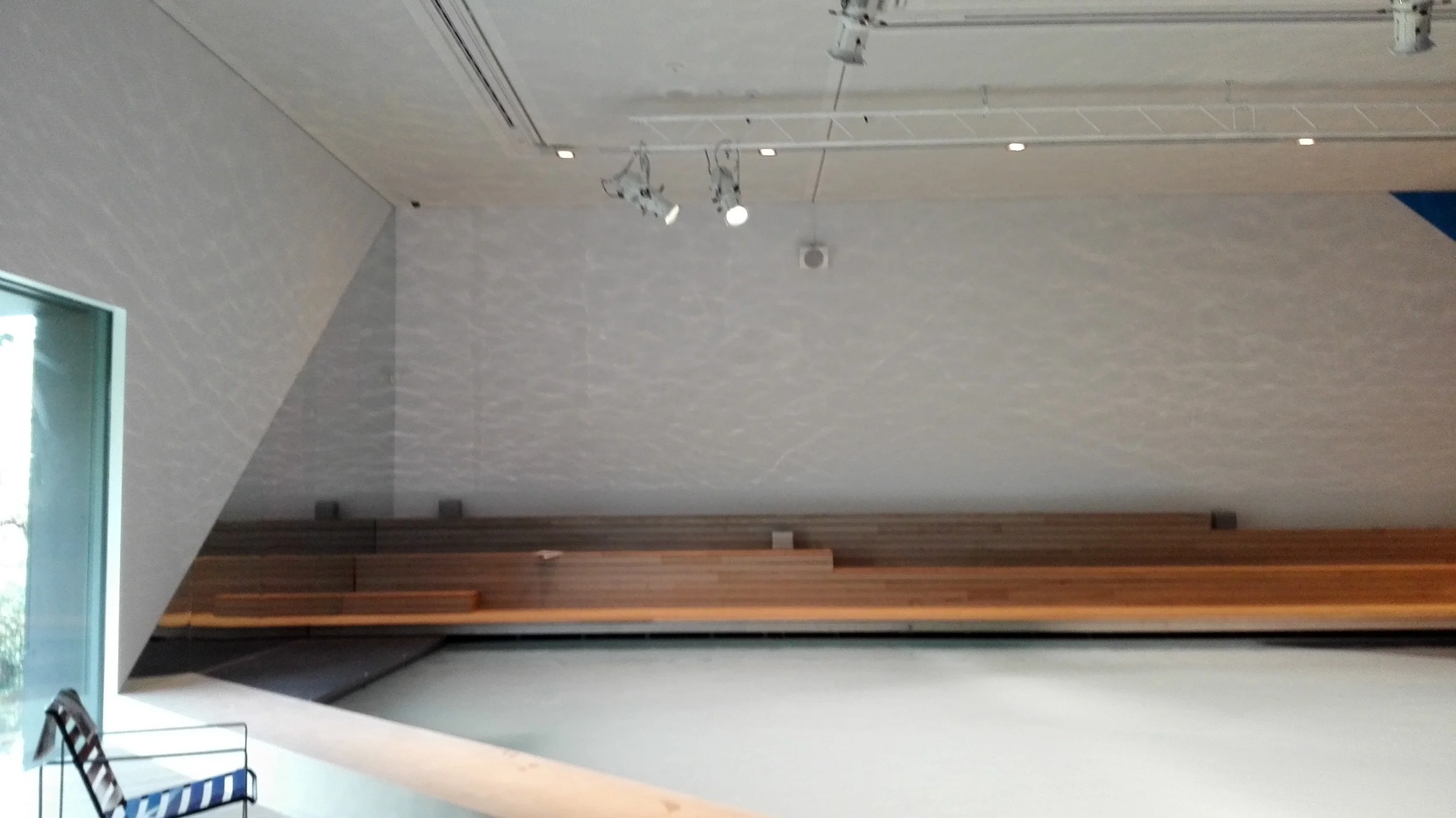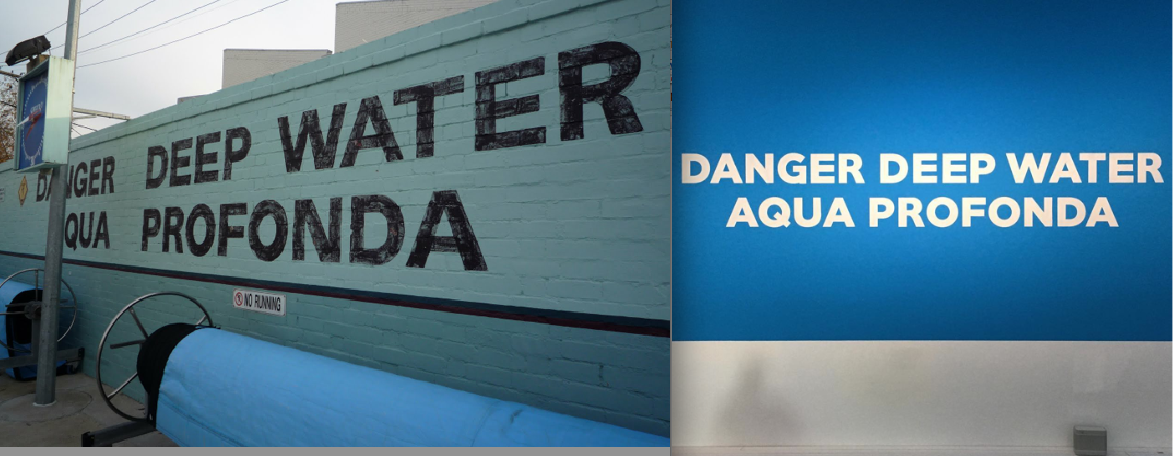state of grace
robert grace writes
In Deep at the Shallow end
Review of
POOL exhibition in the Australian Pavilion at the Venice Biennale 2016
Holliday, Toland and Tabet - creative directors.
Seeing the Biennale
There are different ways of seeing the Biennale and its presentations, you can engage or be engaged. Both I posit are valid ways of experiencing the Biennale. The first requires more energy and time, however it is not necessarily reciprocal in its reward. The second puts the onus on the creatives to compel or be compelling. Neither necessarily guarantees quality content.
POOL EMPTY photo robert grace
Representing POOL
POOL, the Australian exhibition, finds a third way: that of promotion vis-à-vis the integrated creation, control and dissemination of a particularly obfuscated narrative. However the lack of content, architectural proposition or project removes any necessity to veil.
This failure doesn't deter the PR machine from talking a big game. The design team spokeswoman Michelle Tabet, seems intelligent and aware of the arguments, but as she admits she is not an architect, instead a trained urbanist, who has eschewed this to become an independent strategy director.
She is very adept at circling the wagons and protecting her architect partners. This protective structure is underpinned by renowned and exclusive PR Company ING. This is admire-able but far from admirable. If there were a golden lion for PR, ING would be odds-on favourite for the prize.
For POOL the Australian Institute of Architects has created the tightest of teams, their will fashioning and controlling the organisation to perhaps influence the selection of the creative directors. Who have, in return, bought into the AIA’s hype.
All aspects of the presentation of the exhibition are controlled toward a premeditated unchallenging outcome. It makes for a slick product to sell to the national sponsors, as much as any claim to content. Or to put it more succinctly the tail is guaranteed to wag the dog.
As commissioning client, the AIA, only provides about 10% of the $500,000 cost of the POOL exhibition; the rest is funded by architectural firms and commercial sponsors. With those figures the need to satisfy sponsor organisations is almost certainly a factor; but that many of the same architectural firms are part of the coterie is problematic.
When it comes to media publicity, dissent is an anathema, especially with the AIA’s subsidiary Architecture Australia and other design sites and blogs already locked in as sycophantic slugs trailing behind the story. Plus, lazy journalists, alleged commentators and obliging websites are provided with pre-emptive copy that is propaganda peddled as editorial and critique.
Vernissage
At the opening of POOL, Michelle Tabet was front and centre of the other creative directors. Auntie Bea (Ballangarry) a Gumbaynggirr elder, performed a welcoming and water ceremony and spoke a few words about the stolen generation and sorry day. It was over too soon before another elder, commissioner Janet Holmes a'Court acknowledged, at tiresome length, the list of sponsors. Ian Thorpe talked about his relationship with movement, fluid displacement and exchanges with pool water itself. The icing came when the Australian ambassador (recently appointed and up from Rome) made an off-message opening speech about the trade imbalance between Australia and Italy. However he didn’t fail to refer to the proliferation of backyard pools to be seen by all from a plane landing at any Australian city.
welcome & water ceremony Aunty Bea Ballangarry photo robert grace
A more enduring influence is the AIA’s Venice Biennale Committee (VBC) overwhelmingly architects, all with visible egos and not so visible agendas. I’ve experienced them first-hand as a shortlisted creative director candidate. Far from being magnanimous patrons who leave the creative team alone, they meddle. And this year they have once again proved to be Australian architectures’ worst enemy.
It is sheer idiocy to shackle Australia’s creative directors to a Biennale theme announced months later. It not only displays a lack of respect but is oxymoronic. Yet for a decade the VBC has consistently bound Australia’s contribution to an inherent irrelevance with each Biennale theme. This perpetuates compromise and guarantees marginalisation.
POOL exhibition
POOL exhibition is characterised by allusions, omissions and absences.
There are no visual stimuli (plans photos etc). It is blank save a clever use of lighting to make a sparkling constant ripple reflection on the walls. A series of small b&o (Danish) speakers softly broadcast the stories of a few chosen celebrities. Apparently the POOL is the great social leveller? If POOL is an anecdotal survey with some compelling recollections, I doubt that anyone sat down long enough to listen to all eight of them.
There is also an olfactory aspect - a faint lingering unidentifiable odour that was neither chlorine nor brine. It seemed strange that such a familiarity was overlooked by the designers (it is a specially created room perfume) since smell is such a powerful tool to evoke memory.
By contrast, the nostalgically sized “broadsheet” reference rag / mini-catalogue intends to conjure up visions of blokes sitting on bleachers reading the form guide. Entitled, from the edge, but produced after the announcement of the Biennale theme, spins an alignment and relevance of POOL to the Biennale curator Aravena's theme. Lip service at its cynical best. POOL’s biggest failing by far is its attempt to answer everything Biennale whilst tailoring the emperor's new clothes.
Simultaneously POOL avoids the subject of the suburban backyard pool and its pool fence. Almost 20 percent of Australian households have pools; Tabet's claim that they are just smaller neighbourhood communal ones, rings hollow. Since the concentration of these private pools is in more affluent suburbs they are a major preoccupation of architect designed houses and landscapes.
Note the private houses, backyards and pools the biggest belonging to prime minister Turnbull photo stopturnbull.com
If the pool is an “architectural device” as the creative directors write where is its discussion and exploration? Be they communal or indeed private. In from the edge, Pool Talk Australian architects in conversation, we get an inkling of what this might have been. It is only when the architects begin to speak do snippets of “the Australian condition” give us, all too briefly, other signs of life.
Fitzroy then Venice Internet screen grab
The excessively graphic nature of the pool exhibition ultimately results in little more than a geometric and coloured-in line drawing. The aqua blue painted triangles and polished stainless steel alternatively fold and reflect the space. The bleachers themselves are minimal stripped back blocks. It is not really a pool but a triangular segment of a pool. The duality of the signs - deep water - on the wall and - shallow water - by the pool is never explained. The exhibition book might hold in-depth information but it is excluded from the POOL experience, unless of course you know about it, buy it and sit down to read it for a few hours.
SHALLOW photo robert grace
In the absence of visual cues, Visitors thought POOL was a huge foot bath for their weary feet. A lot of people did just that in true European style. A rogue swimmer even flouted an apparent / unannounced interdiction. He got out of the 30cm deep pool just as the police arrived. [james russell swims] https://www.instagram.com/p/BF6qXTCG68-/ Momentarily, POOL made a pool that you couldn’t swim in, a rarefied simulacra.
Otherwise, the overall feeling is one of abstract quiet, due in large part to DCM's gallery’s high level of sound insulation. The installation, a singular immersive (not my words) experience, is overwhelmed by the gallery’s severe aural isolation and denies POOL any resonance that characterises an internal pool.
In the end POOL is a dumb stage set - an outdoor experience transferred into an air conditioned gallery longing for a performance it denies.
It is unsurprising then that POOL also ignores the essential differences between the indoor and outdoor pool. Whilst in the publications (book and broadsheet) there is a predominance of beautiful images of outdoor pools, the indoor pools shown are training, sporting and aquatic centres. No distinction is proffered.
In Australia outdoor pools are fundamentally a beach substitute, a place where you can be under the sun with the possibility of relief and release in cooling water. People decide how much of themselves/skin they want to expose. The specific attraction is being OUTDOORS.
On the other hand there is the swimming, the practical activity for all Australians, as a matter of survival, especially at the ocean. The pool is a staging ground for a later assault at the beach, a rite of passage. Could it be about the action of SWIMMING ? It was only Ian Thorpe who approached this in his recollection of the feeling of being in water.
Indoor pools are places of concentrated exercise and of sporting competition where swimming takes place in all weather. WEATHER, the root of most, if not all, outdoor lifestyle in Australia is never discussed by POOL. Neither is CLIMATE.
The flaw behind POOL.
POOL’s flaw is neither hidden behind the ING PR campaign nor the AIA’s VBC tricky manoeuvres to be relevant to a Biennale theme it has no empathy with. POOL is no summum of the Australian condition. Pools are loci of formative memory and social interaction whether conflictual, harmonious or neutral, but no more so than the beach, the river, the lake, the pub, the public square …..
The flaw is that POOL falls short of achieving even a metaphoric swimming pool. What is given is analogous to a foot bath or at best an ornamental wading pool of calf-high water.
Inconvenient issues of social inequality, drought, pollution, cultural dissonance, racism, massacre, genocide, unimaginable violence, incarceration, institutional kidnapping, youth suicide, asylum and exclusion are not dealt with or only partly identified and acknowledged. Instead they are alluded to as a way of avoiding both the nasty bits and what could be revered in an 80,000 year old culture.
Rather, Nostalgia is the driving force for the creative directors, the series of stories set to evoke memories with their inherent distortions and fabrications, of combined experiences that we whimsically long to relive. Existing to deceive us about the past, it is a dead end.
Nostalgia’s positive counter - Melancholy - recognises the irreversibility of the loss of a past (event or emotion). A past that might not have been all that good anyway. POOL alludes to this but fails by letting the “niceness” of Nostalgia for a GOOD LIFE dominate.
Architecture’s role like Melancholy is to dispel Nostalgia by engaging intellectual and creative energies in order to come to terms with our particular historical condition. It is by confronting real problems facing a society and by moving away from allusion and mere identification; toward real propositions and projects to rectify past and current failures that it can lead, in its own way, to a better future.
Pool is another missed opportunity, once again offering what is becoming the essentially Australian Venice experience of shallowness.
robert grace is principal at robert grace architecture & founder state of grace




